

Taher jaber
Educational consultant and school developer
الفصل الثالث النظرية في التربية. الفصل الثاني بناء النظرية. الفصل الرابع نظرية المنهج. الفصل الرابع نظرية المنهج. الفصل السادس تصميم المنهج. الفصل السابع هندسة المنهج. ملخص كتاب جورج بوشامب. Critical Thinking. Critical Thinking. Deeper Learning: Authentic Student Assessment. Is it possible to systemically embed deeper learning outcomes for students?
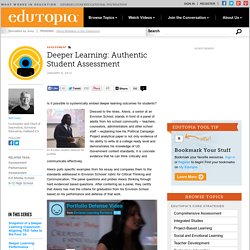
Dressed to the nines, Alexis, a senior at an Envision School, stands in front of a panel of adults from his school community -- teachers, counselors, administrators and other school staff -- explaining how his Political Campaign Project analytical paper is not only evidence of his ability to write at a college ready level and demonstrates his knowledge of US Government content standards, it is concrete evidence that he can think critically and communicate effectively. Alexis pulls specific examples from his essay and compares them to the standards addressed in Envision Schools' rubric for Critical Thinking and Communication. The panel questions and probes Alexis thinking through hard evidenced based questions. After conferring as a panel, they certify that Alexis has met the criteria for graduation from his Envision School based on his performance and defense of that work. 1. 2. 3.
Deeper Learning: Authentic Student Assessment. Critical Thinking From The Ground Up. Critical Thinking From The Ground Up. Critical thinking. Critical thinking is a type of clear, reasoned thinking.

According to Beyer (1995) Critical thinking means making clear, reasoned judgements. Always be innovating: Preloaded on success, failure and games with purpose - edugameshub. I’ve been following the fortunes of games agency Preloaded for several years now, and worked with them on a number of projects.
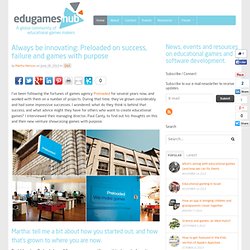
During that time, they’ve grown considerably and had some impressive successes. I wondered: what do they think is behind that success, and what advice might they have for others who want to create educational games? I interviewed their managing director, Paul Canty, to find out his thoughts on this and their new venture showcasing games with purpose. Martha: tell me a bit about how you started out, and how that’s grown to where you are now. Paul: We set up Preloaded over 13 years ago now, with a remit to do work of creative quality that we felt was lacking in larger digital agencies.
Games were a constant output of our work, although we did a range of other things too, from corporate websites for the likes of the Arts Council through to innovative content based apps like the first Net A Porter app. Process is also vital to ensuring the best output. P: Tons! Survey: Learning '21st-Century Skills' Linked to Work Success - Teaching Now. A study released today by the polling firm Gallup Inc. finds that students' exposure to so-called 21st-century skills in school correlates positively with "perceived quality of work" later in life .
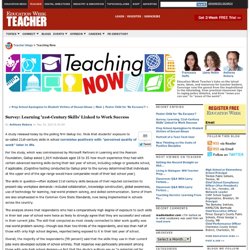
For the study, which was commissioned by Microsoft Partners in Learning and the Pearson Foundation, Gallup asked 1,014 individuals aged 18 to 35 how much experience they had with certain advanced learning skills during their last year of school, including college or graduate school, if applicable. (Cognitive testing conducted by Gallup prior to the survey determined that individuals at the upper end of the age range would have comparable recall of their last school year.) Deeper Learning: Performance Assessment and Authentic Audience. In a conversation with a veteran educator -- a man with years of experience teaching English and acting as a headmaster -- I was confronted with a prejudice so ingrained in my teaching that I was almost embarrassed to admit it.
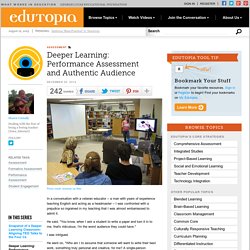
He said, "You know, when I ask a student to write a paper and turn it in to me, that's ridiculous; I'm the worst audience they could have. " I was intrigued. He went on, "Who am I to assume that someone will want to write their best work, something truly personal and creative, for me? A single-person audience is a pretty lame audience, let alone the fact that I'm a middle-aged white guy.
" That hit me like a rolled-up newspaper. As I absorbed this veteran educator’s words, I realized that not only was I wrong in my assumption that I (or any teacher) is a meanigful audience, but also that my assumptions about how grading and assessment work were so far removed from modern research that I might as well have been a 21st-century doctor treating humours. This matters. 1. 2. 10 Team-Building Games That Promote Collaborative Critical Thinking. One of education’s primary goals is to groom the next generation of little humans to succeed in the “real world.”
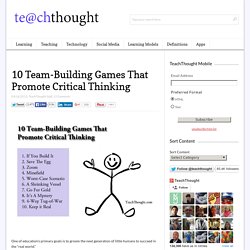
Yes, there are mounds of curricula they must master in a wide breadth of subjects, but education does not begin and end with a textbook or test. Other skills must be honed, too, not the least of which is how to get along with their peers and work well with others. This is not something that can be cultivated through rote memorization or with strategically placed posters. Students must be engaged and cooperation must be practiced, and often. The following team-building games can promote cooperation and communication, help establish a positive classroom environment and — most importantly — provide a fun, much-needed reprieve from routine. 10 Team-Building Games That Promote Collaborative Critical Thinking 1.
This team-building game is flexible. You can recycle this activity throughout the year by adapting the challenge or materials to specific content areas. 2. 3. 4. Critical Thinking Abilities. Weak versus Strong Critical Thinking Critical thinking involves basic intellectual skills, but these skills can be used to serve two incompatible ends: self-centeredness or fair-mindedness.
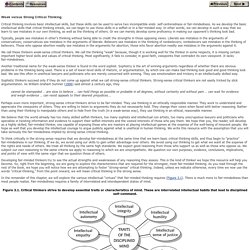
As we develop the basic intellectual skills that critical thinking entails, we can begin to use those skills in a selfish or in a fair-minded way. In other words, we can develop in such a way that we learn to see mistakes in our own thinking, as well as the thinking of others. Or we can merely develop some proficiency in making our opponent's thinking look bad. Critical Thinking Abilities. Games and your brain: how to use gamification to stop procrastinating. 1.4K Flares Filament.io 1.4K Flares × It is Thursday afternoon.
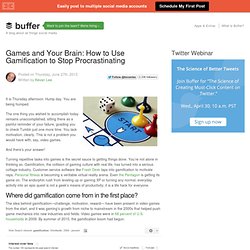
Hump day. You are being humped. The one thing you wished to accomplish today remains unaccomplished, sitting there as a painful reminder of your failure, goading you to check Tumblr just one more time. You lack motivation, clearly. And there’s your answer! Turning repetitive tasks into games is the secret sauce to getting things done. Where did gamification come from in the first place? The idea behind gamification—challenge, motivation, reward— have been present in video games from the start, and it was gaming’s growth from niche to mainstream in the 2000s that helped push game mechanics into new industries and fields.
The spark for the gamification boom is often traced to technology apps like Foursquare, which popularized ubiquitous badges for highly engaged users, and social games like Zynga’s FarmVille, which achieved huge commercial success on Facebook with its infinite reward system. Endorphins power our love for games. Eight Ways of Looking at Intelligence. Big Ideas In “Thirteen Ways of Looking At A Blackbird,” poet Wallace Stevens takes something familiar—an ordinary black bird—and by looking at it from many different perspectives, makes us think about it in new ways.
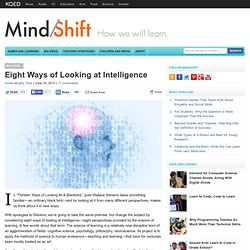
With apologies to Stevens, we’re going to take the same premise, but change the subject by considering eight ways of looking at intelligence—eight perspectives provided by the science of learning. A few words about that term: The science of learning is a relatively new discipline born of an agglomeration of fields: cognitive science, psychology, philosophy, neuroscience. Its project is to apply the methods of science to human endeavors—teaching and learning—that have for centuries been mostly treated as an art. As with anything to do with our idiosyncratic and unpredictable species, there is still a lot of art involved in teaching and learning. 1. Situations can be internal or external. On one level this is obvious, but on another it is quite radical. 2. 3. 4. 5. 6. 7. How to Implement Deep Learning Characteristics in the Classroom.
Deep learning is the foundation on which I instruct my students; whether it is through the use of practical thinking skills, human dimension activities, and/or data gathering.

There are other deep learning characteristics I implement daily, but these are most commonly used in my classroom. These strategies help to... Deep learning is the foundation on which I instruct my students; whether it is through the use of practical thinking skills, human dimension activities, and/or data gathering. There are other deep learning characteristics I implement daily, but these are most commonly used in my classroom. These strategies help to keep me focused on one common goal for all my students: to promote better learning outcomes for all students-ones that are transformational. How 21st Century Thinking Is Just Different. How 21st Century Thinking Is Just Different by Terry Heick This content is proudly sponsored by The Institute for the Habits of Mind, promoting the development of personal thinking habits in 21st century learners.
In an era dominated by constant information and the desire to be social, should the tone of thinking for students be different? Thinking skills. There is no logic in connecting an office copier with 'nose'. That is to say, there is no 'logic' in our normal undertanding of logic. This understanding is based on passive surface information systems. There is, however, the logic of active surface information systems, and that is the logic of a patterning system. In such a system, the putting together of 'copier' with the random input 'nose' is perfectly logical. At the same time, the juxtaposition is a logic of action. 25 Critical Thinking Strategies For The Modern Learner. Critical thinking is the engine of learning. Within this complex process or so many other relevant themes that contribute to learning: creativity, analysis, evaluation, innovation, application, and scores of other verbs from various learning taxonomies.
So the following infographic from Mentoring Minds is immediately relevant to all educators, and students as well. It’s a bit of a mash of Habits of Mind, various 21st century learning frameworks, and the aforementioned learning taxonomies, promoting collaboration, problem-solving, and real-world connections (standard “critical thinking fare” with Habits of Mind-sounding phrases such as “Open-Mindedness”). At the bottom, it pushes a bit further, however, offering 25 critical thinking strategies to help support progressive learning.
While a few are a bit vague (#12 says to “Think critically daily,” and #17 is simply “Well-informed”), overall the graphic does pool together several important themes into a single image.